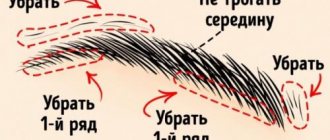How does the buckwheat diet work?
The buckwheat diet belongs to the class of mono-diet, that is, the main product is buckwheat. Therefore, every day, morning, afternoon and evening, you only need to eat porridge without salt and spices.
Nutritionists offer more gentle diets. The advantage is the fact that there are no restrictions on the consumption of cereals. Although it is difficult to eat more than a glass a day, and for greater effect, it is better to reduce the portion every day.
The diet works due to the absence of fast carbohydrates in the diet. This is a trigger for rapid fat burning. After all, fast carbohydrates provide energy, and if they are not there, all the excess fat goes into the firebox.
The main feature of the buckwheat diet is the ability not to worsen the general condition of the body, but even, on the contrary, to improve it.
The best method of preparation is considered to be brewing buckwheat. This way the maximum amount of nutrients will remain in it. After pouring boiling water over the cereal, wait a couple of hours and the dish is ready.
Or leave the soaked buckwheat overnight, covering it with a towel or blanket. Cereals:water=1:2. Due to the content of B vitamins and proteins, buckwheat is very popular among vegetarians and is considered a good meat substitute. Unprocessed green cereals are better suited for the diet.
The procedure for introducing other products into the buckwheat diet
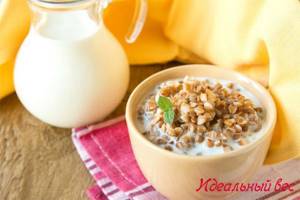
From the first day of the diet, it is allowed to consume kefir or yogurt without additives and with reduced fat content (no more than 1%). However, if you can do without it for the first few days, it is better to introduce it on the third or fourth day. In the first days, the body gets involved in the work of cleansing and the protein found in buckwheat will be enough for it. If you feel weak (this is possible due to changes in the body), introduce kefir into your diet from the first days. The permissible norm is no more than one liter per day. You can drink it between meals. Instead of boiling water, you can pour kefir into the cereal overnight, but nutritionists still recommend consuming it separately.
Another recommendation is to organize meals in small portions every two hours. This way, nutrients are distributed evenly into the blood, thereby maintaining stable sugar levels. This creates a feeling of satiety, and there are no mood swings or blood pressure changes. In addition, the body learns to receive food at a certain time. By the end of the first week, you will feel hungry only when the time to eat approaches.
The greatest weight loss is observed after the first week. This removes excess water, toxins and other harmful substances that have accumulated over the years from the body. To help your body, drink as much fluid as possible. It’s good if it’s ordinary clean water, but green tea without sugar is also allowed. The daily norm is approximately 2 liters.
From the second week, you can add some dried fruits or one teaspoon of honey to the porridge for taste.
The third option is a recipe for buckwheat balls. To prepare them, ready-made buckwheat porridge is ground in a blender and then formed into small balls slightly smaller than a walnut. After this, they can be slightly dried in the oven. Take in times of exacerbation of hunger. This is an excellent alternative to regular porridge, since the taste of the balls is similar to cookies. It is also not recommended to add salt and spices to buckwheat minced meat, but you can add a little lemon juice or vegetables.
Watermelon diet for weight loss
Buckwheat diet for 3 days
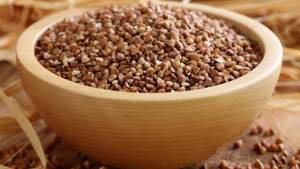
Three days is a short period of time, so the most effective would be to choose a strict buckwheat diet. There should be nothing in it except buckwheat and water. In other diets, the consumption of certain foods is acceptable, but they are not as effective. If it is too difficult to start with this method, there is a better way out. It consists of including buckwheat soup in your diet. It has only advantages and no disadvantages. This soup is prepared according to a special recipe, which includes room for vegetables. It still remains effective and low-calorie, but for the beginning of the “diet” path it will be more gentle both for the psychological component and for the body as a whole. The first course, rich in vitamins and very tasty, can also be consumed during the normal diet.
Buckwheat soup recipe
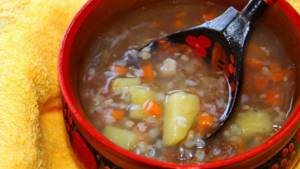
To prepare you will need:
- 3 liters of clean water;
- 1 cup buckwheat;
- 2 onions;
- 2 tomatoes;
- 1 carrot;
- 5 cauliflower inflorescences;
- 1 sweet pepper;
- 1 tbsp. olive oil.
Chop all the vegetables except cauliflower and place in a heated frying pan with olive oil. Simmer for 10-15 minutes. Add buckwheat, cauliflower and stewed vegetables to boiling water. Cook until tender (about 30 minutes), at the end you can add some greens. Delicious dietary soup is ready. You need to eat it during the day. During breaks you need to drink only clean water. It is also possible to adjust your diet during these three days, that is, you can eat only soup on the first day, only buckwheat on the second, and, for example, soup again on the third. It’s delicious and more or less easily tolerated by the body.
How to properly cook buckwheat while on a diet
As part of the diet, boiled porridge is consumed. It's very easy to prepare. You should wash the cereal, remove black grains and remaining husks from it. Pour water into the pan in a two to one ratio. After it boils, place buckwheat in it. Cook until all the water has evaporated.
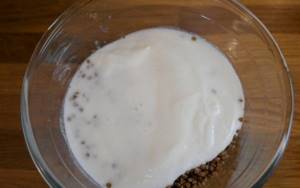
When dieting, buckwheat is often consumed without cooking. You can prepare it in two ways - by pouring boiling water or kefir.
You need to cook porridge with water like this:
- Place 1 cup of washed cereal in a thermos.
- Pour it with just boiled water (150 ml).
- Drain the liquid.
- Pour boiling water again.
- Leave to infuse overnight.
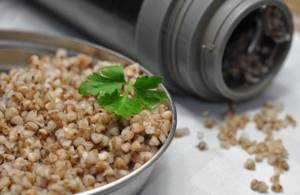
Another option is to steam the cereal closed for 30–40 minutes. You can fill the cereal not just with water, but with low-fat kefir (1%).
Buckwheat diet for weight loss for 7 days
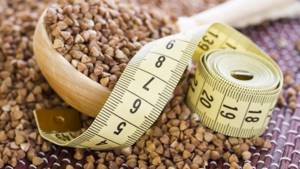
If this is the first strict diet, it is better to spare yourself and your body a little. After all, a strict buckwheat diet for weight loss for 7 days is far from an easy test. Yes, you can lose up to 10 kg in a week, but at such a price?! After all, 6 kilograms in a simplified mode is also a good result, and no harm to health.
Nutritionists have tried to develop a more gentle buckwheat diet for a week. It allows the consumption of vegetables and fruits, but you should not abuse them. The main thing is to drink as much clean water as possible and not eat too often.
Buckwheat diet menu for 7 days
(Buckwheat porridge without spices)
1st day:
- breakfast – buckwheat, carrot and cabbage salad with lemon juice;
- lunch – buckwheat, vegetable soup, hard-boiled egg;
- dinner – buckwheat, vinaigrette with olive oil without pickles.
2nd day:
- breakfast – buckwheat, tomato and cabbage salad;
- lunch – buckwheat, vegetable sauté;
- dinner – buckwheat, cottage cheese 100 grams.
3rd day:
- breakfast – buckwheat, baked apple;
- lunch – buckwheat, boiled chicken fillet;
- dinner – buckwheat, prunes 3 pcs.
4th day:
- breakfast – buckwheat, asparagus salad with lemon juice;
- lunch – buckwheat, lean borscht (how to cook borscht without frying);
- dinner – buckwheat, baked pumpkin.
5th day:
- breakfast – buckwheat, broccoli salad with olive oil;
- lunch – buckwheat, light fish soup;
- dinner – buckwheat, orange.
6th day:
- breakfast – buckwheat, bean and cucumber salad;
- lunch – buckwheat, vegetable broth;
- dinner – buckwheat, a glass of low-fat kefir.
7th day
- During the day, drink 1.5 liters of vegetable juice diluted with water 1:1.
Snacks are not allowed; it is better to give the body a little physical activity, this will give a greater effect. In a week, the buckwheat diet gives excellent results - up to minus 8 kg of weight.
Attention!!! The main thing is to “listen to your body” and not abuse the strict regime. If this is not the first serious diet, then it is better to exclude everything except water and buckwheat.
How to properly lose weight on a buckwheat diet and how effective is it?
The word diet (in Greek diaita) is a way of life. Its other meaning is diet. In the current understanding, a diet is a diet that presupposes a certain ratio of food products, the technology of their culinary processing, and establishes certain intervals in food intake.
As a method of treatment, diet has been used since ancient times, but in the past its principles were based on experience. With the discovery of the law of metabolism, the achievements of various sciences - chemistry, physiology - began to be taken into account when preparing diets.
Modern dietetics takes into account the principle of the body’s physiological need for nutrients. This principle comes from the idea of a balanced diet.
Attention!
When metabolic processes in the body are disrupted by disease, diet should become a regulating factor.
Regulation of metabolic processes in a sick body through diet can be achieved through the selection of food products and special technological methods of food processing.
Diets may have names, for example: protein, fat, potassium, etc. Their purpose is due to certain metabolic disorders, in which the body requires the introduction of chemicals in a certain proportion. There are names of diets based on the names of their authors.
In addition to diets prescribed for individual indications. Fasting days are also used, which are a type of diet and are prescribed for a short time, usually for 1-2 days. Fasting days are used to create a negative energy balance in the body in order to restore weight.
Protein fasting days include fish, meat, cottage cheese, potassium - foods rich in potassium (dried apricots, apricots, vegetables and fruits, milk).
The most common are fasting days, named after the product being introduced: meat, fish curd, sour cream, vegetables, fruit, etc.
Fasting days, however, like any other diet, are used to stimulate or, conversely, have a gentle effect on the functions of individual organs and systems of the human body, and have different effects on metabolic processes.
Important!
Currently, the buckwheat diet has gained great popularity, the meaning of which is to eat buckwheat steamed for several hours without using salt or any seasonings. It is allowed to eat low-fat kefir together with buckwheat prepared in this way.
This diet is recommended for the purpose of losing excess weight. This diet is quite strict, as it is associated with fairly strict dietary restrictions for a long time - 7-10 days. Sometimes it is recommended to use it for up to 14 days.
Literary sources and Internet publications speak of its sufficient effectiveness in order to lose weight irreversibly and in a short time. The simplicity of using this method also deserves attention, but why doesn’t everyone lose weight on a buckwheat diet?
Buckwheat is not a scarce or expensive food product. The point of the buckwheat diet is that you can eat as much buckwheat as you want during the day. The carbohydrates contained in cooked buckwheat are slowly digestible and do not contribute to the accumulation of fat in the body, but, on the contrary, promote the burning of accumulated fat.
Buckwheat gives you a feeling of fullness. Therefore, those losing weight on this diet will not feel the feeling of constant hunger. In most cases, the buckwheat diet is tolerated without problems and easily.
Like all diets that are used to lose excess weight, there are pros and cons.
P (rutin), PP (nicotinic acid), B vitamins, as well as microelements (potassium, magnesium, iron, phosphorus, iodine). The vitamins contained in buckwheat help strengthen capillaries, cleanse the liver, and rid the body of toxins. By eliminating salt from the buckwheat diet, the body gets rid of excess water. The fiber contained in buckwheat helps rid the body of toxins.
Among the negative aspects of the buckwheat diet, it should be noted that, despite not all the richness of useful substances, they are still not enough for the normal functioning of the human body as a whole.
The lack of simple sugars in the body can negatively affect the functioning of organs and systems, in particular the functioning of the brain.
Lack of salt in the diet can lead to low blood pressure, which is risky if you have hypotension.
Advice!
The buckwheat diet is contraindicated for people with diseases of the stomach and duodenum, and diabetes. It is strictly contraindicated during pregnancy and breastfeeding.
The buckwheat diet helps not so much to get rid of extra pounds, but rather helps to normalize weight gained as a result of poor nutrition, overeating on vacation, long holidays, and stress. However, you need to know why not everyone will lose weight on a buckwheat diet.
The buckwheat diet is practically ineffective with a normal weight-to-height ratio.
Weight loss with the buckwheat diet is achieved due to a meager diet and its low calorie content. Long-term use of the buckwheat diet borders on hunger strike. And when you come out of such a stress-like state, the body will again begin to absorb foods to maintain energy balance, followed by weight gain.
This diet is ineffective if your metabolism is impaired.
It can be concluded that, indeed, the buckwheat diet, used as fasting days, helps to normalize metabolic processes and reduce weight as a result of poor nutrition associated with an imbalance between food components, such as fats, proteins and carbohydrates.
Vote for best answer
Irina Mudrets (13222) 9 years ago
1 kg - 5 days, this is “losing weight”
Irina Guru (3008) 9 years ago
give it up, on the contrary, I gained weight on the buckwheat diet, I also heard a lot of advice about it, but there’s no point, it’s high in calories like any porridge, it’s better to lose weight by counting calories, 700 cal a day, and buckwheat is nonsense
Good old buckwheat will help you quickly lose those extra pounds! And most importantly, you will not experience a painful feeling of hunger. No “liquid chestnuts”, “chia seeds” and even diet pills can compare with the effect that the buckwheat diet gives.
Iron, magnesium, vegetable protein, vitamin B, potassium and calcium contained in cereals will cleanse the body of waste and toxins. This means that within a week you will feel light in your body and will be happy with the mark on the scales. And all this – without harm to health!
Do you dream of losing weight? Then hurry up and buy buckwheat in the store.
We suggest you familiarize yourself with How to quickly boost an adult’s immunity at home using folk remedies
Tired of excess weight and difficulties with choosing a wardrobe? Tired of turning away from the mirror in disgust and constantly, however, quite unsuccessfully, trying to suck in your stomach? Do you want ease of movement and a slender figure with which you can wear anything you want without thinking? It's simple - go on a diet! And we’ll tell you which one!
Dieting starts with a firm decision. First you have to convince yourself that it is worth it and that certain deprivations now will help you feel better and definitely look better in the near future.
This is something that, without harming the body, will allow you to lose 3-7 kg in a week. This is the diet that can relieve you of excess weight and most digestive problems. This is exactly the relief that an organism clogged with toxins needs. The buckwheat diet is not a panacea, but it is a really worthwhile thing.
As you already understand, the basis of the buckwheat diet is buckwheat. Unlike other popular diets today, this one does not contain anything other than the product from which it takes its name.
The diet involves eating exclusively buckwheat boiled in water, without salt and oil, 3 times a day. Have you tried oat bran for weight loss? If not, then run to read our article and then go to the store for this miracle food.
My sister lost 6 kilograms on the buckwheat diet in 5 days, and I need to lose 8 kilograms in 10 days for my friend’s wedding. Judging by the results that my sister achieved, I can lose 8 kilograms in 10 days. I have already psychologically tuned in to the buckwheat diet and thoroughly studied all the intricacies of the diet.
Here is how to properly lose weight on a buckwheat diet so that the weight loss effect is as beneficial and effective as possible:
- Firstly, buckwheat porridge does not need to be cooked - it needs to be steamed with boiling water in a small saucepan in the evening and then wrapped in a warm towel or blanket so that the porridge itself reaches a state of readiness.
- Do not under any circumstances add salt, sugar or milk to the porridge.
- And so, we take half a kilogram pack of buckwheat (not used) and fill it with 1.5 liters of boiling water - we get the volume of ready-made porridge that is needed for the day.
- Every 2-3 hours you need to eat buckwheat porridge in small portions - approximately 150 grams.
- Drink about a glass of clean water between meals.
- It is allowed to drink a glass of low-fat kefir -1% fat content at night.
I want to say that I tried to do fasting days on such a diet and the result simply delighted me - 1 kilogram is lost per day, but so far I have only done two such fasting days in a month and the lost kilograms have not returned.
Now I'm in a hurry and I want to try a diet for 10 days. I am not afraid of the diet, since fasting days on buckwheat porridge showed that I tolerate such a diet well.
Therefore, I advise everyone before starting a buckwheat diet - sit on fasting days first and you will be able to understand whether the buckwheat diet is suitable for you or not.
October 07, 20173729 reads
According to statistics, the buckwheat diet has been and remains the leading position among the most popular weight loss methods. The reviews and results of losing weight on buckwheat are simply amazing: with this diet you can achieve your desired weight. What is the reason why buckwheat porridge became the basis?
Buckwheat diet for 14 days
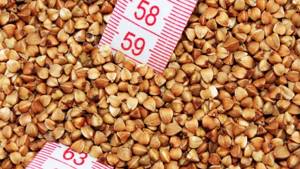
The 14-day buckwheat diet for weight loss is the ideal gentle way to say goodbye to extra pounds and stabilize your body. The diet includes all the necessary products for normal functioning. Nutritionists advise including in the menu:
- low-fat fermented milk products;
- apples in any form as a snack;
- dried fruits and honey - if you perform physical activity during the period of weight loss.
Approximate buckwheat diet menu for 14 days:
Morning diet:
- buckwheat porridge + apple + 200 ml low-fat kefir;
- buckwheat porridge + dried fruit + weak tea without sugar;
- a portion of buckwheat porridge, which has been standing in kefir since the evening;
- buckwheat porridge + fruit or vegetable salad + tea.
Daily diet:
Breakfast dishes are also suitable for lunch. You can supplement them with salad according to the recipe:
- 1 beet;
- 150 g white cabbage;
- ½ celery root;
- 1 carrot.
Grind all the vegetables, add a little lemon juice and olive oil, stir thoroughly.
Evening diet:
A few hours before bedtime, eat ½ serving of buckwheat porridge and salad. If you feel a strong feeling of hunger, snack on an apple or low-fat kefir.
The results of a 2-week buckwheat diet will not keep you waiting - minus 15 kg is really possible if you don’t let yourself relax. The best effect can be achieved if you do physical activity or go to a fitness center.
How much can you lose in a month if you eat one buckwheat?
Buckwheat mono-diet is a popular, simple and effective method of combating excess weight. It has pros and cons, indications and contraindications, positive and negative reviews. Read more about this below.
How to lose weight on buckwheat
Losing weight on buckwheat is both easy and difficult . It's easy because the process is extremely simple. It’s difficult, because not everyone can withstand the restrictions imposed by this diet.
Features of the buckwheat diet
The effect of a mono-diet is based on two main factors.
Firstly, buckwheat contains slow carbohydrates, which are absorbed gradually and provide a feeling of fullness for a long time.
Secondly, since the body experiences an energy deficit due to a reduced intake of calories, it begins to break down fat reserves.
Reference.
Buckwheat contains a lot of fiber (10 g per 100 g of cereal), the consumption of which leads to cleansing of the body; vitamins B1, B2, PP, organic acids (oxalic, malic, citric) and minerals (magnesium, copper, manganese, iron, sulfur, etc.). 100 g of cereal contains 58.2 g of slow carbohydrates, 13 g of protein and 3.6 g of fat. Calorie content - 308 kcal per 100 g, for boiled in water - three times less.
Varieties of buckwheat diet
Since this diet is one of the strictest even among mono-diets, several variants have been developed for some variety .
Firstly, the mono-diet itself - unlimited consumption of only steamed buckwheat . At the same time, drink at least 2 liters of water per day.
Secondly, buckwheat-kefir: , up to 1 liter of 1% kefir is allowed per day
And lightened, when additional components are allowed to make the diet more balanced : low-fat dairy products, unsweetened fruits and dried fruits, honey, herbs, boiled chicken breast.
The essence of the buckwheat diet
In its most rigorous form, the diagram looks like this:
- Drink 0.5 liters of water on an empty stomach.
- After half an hour, eat the first portion of pre-steamed buckwheat without salt (steam the cereal with hot water in a 1:2 ratio in a thermos or saucepan).
- After another half an hour - 1 glass of water.
- After 30-60 minutes - again a portion of buckwheat, etc.
The amount of cereal eaten per day is not limited . If desired, replace 1-2 glasses of water with green tea without sugar. You need to hold out from 3 to 14 days.
In the buckwheat-kefir version, up to 1 liter of 0-1% kefir is added to 2 liters of water and an unlimited amount of buckwheat . It is drunk separately, 30 minutes before porridge (or 30 minutes after it). The second method is to soak 1 tbsp overnight. cereals in 2 tbsp. kefir If this amount is not enough for a day, the dose is doubled.
There are also several lighter variations:
- Curd and buckwheat diet. Add 350-400 g of low-fat cottage cheese per day to the porridge. This amount is distributed evenly between all meals.
- Add 2-3 boiled skinless chicken breasts per day to the porridge. They are eaten mainly in the second half of the day; in the first half they eat mainly porridge.
- Buckwheat diet with dried fruits: porridge, 2 liters of water and no more than 100 g of dried fruits (dried apricots, figs, dates, prunes) per day. They are either added to porridge or eaten separately. The disadvantage is that the effectiveness of the diet decreases (the daily calorie content increases). In another option, dried fruits are replaced with fresh apples or grapefruit - no more than two per day. Some nutritionists allow bananas.
- Even softer options. Along with the products described above, vegetables (cucumbers, tomatoes, all types of cabbage, peppers), eggs, lean meat and fish are allowed. When using them, you must select a maximum of three products in an amount of no more than 200 g.
It is important to follow a number of rules:
- For greater efficiency, it is recommended to use green buckwheat rather than regular fried cereal.
- Do not eat food later than 19:00.
- Sleep at least 8 hours a day.
- Add some physical activity. This will improve efficiency.
- During the diet, take multivitamins.
- Follow the rules for exiting the diet.
Rules for quitting the diet
To ensure that the weight does not return after the end of the diet, it is important to exit it correctly . The exit rules are as follows:
- Buckwheat (already lightly salted) should be on the table at least once a day for two weeks.
- Meals should remain fractional, that is, you need to eat often (at least 6 times a day), but in small portions.
- Alcohol is excluded.
- After 19.00, eating is not advisable. A light snack is allowed (a glass of 1% kefir or unsweetened yogurt), but no later than 2 hours before bedtime.
- High-calorie, fatty, spicy, sweet foods are introduced into the diet gradually, starting from the seventh day after the end of the diet.
- Daily caloric intake for two weeks should not exceed 1500 kcal.
- Physical activity and the amount of daily water consumption remain the same.
- Once a week, a fasting day (for example, kefir) is necessary.
Compliance with these rules will improve the result by another 2-3 kg.
Benefits of the buckwheat diet
The advantage of the buckwheat diet is its simplicity, as well as:
- You don't need to eat by the clock. Easy to plan menu.
- Cereals are inexpensive and the cooking process is as simple as possible.
- The result is achieved quickly, its dynamics are good (on average 1 kg per day).
- Suitable for vegetarians.
- The cereal is nourishing and contains many essential substances.
- Buckwheat is a medium-calorie product.
- There is no gluten, the risk of allergies is minimized.
Is this diet balanced?
There are also disadvantages. The main one is an incompletely balanced diet . The diet is salt-free, so a lot of fluid is removed from the body. Because of this, in some cases, fasting people experience headaches and increased fatigue. It must be borne in mind that after the water-salt balance is restored, the weight will increase slightly.
Attention! Since buckwheat still does not contain all the substances necessary for the body, following a diet often leads to vitamin deficiency, exacerbation of chronic diseases, and even low blood pressure.
How many kilograms can you lose on buckwheat?
This diet is quite effective and on average allows you to get rid of 1 kg every day . But the duration of a strict diet should not exceed 14 days, since in some cases, after this period, the body becomes accustomed to the regime, and the weight loss process stops.
What happens if you eat only buckwheat for a month?
If you want to extend the diet for a month or more, keep in mind that the body will respond with disruptions . The most common reaction is constipation. Possible indigestibility of cereals due to a failure in the production of enzymes necessary for its digestion (depletion of function).
There may be disturbances in the functioning of the urinary system and kidneys, even hormonal imbalance is possible.
Possible harm and contraindications
The diet also has a number of contraindications . These include:
- diseases of the gastrointestinal tract;
- endocrine system disorders;
- diseases of the cardiovascular system;
- hypotension;
- diseases of the musculoskeletal system;
- pathologies of the urinary system;
- pregnancy and lactation period.
Reviews and results of losing weight
Reviews about the buckwheat diet are varied. Some are crazy about her, others absolutely dislike her.
Irina, 31 years old : “The results were impressive. I set a goal to lose 10 kg. I weighed 65 kg with a height of 1.62 m. Before starting the diet, I tried buckwheat as a fasting day. I stood it easily, so I decided to move on.
I strictly followed the plan for a week, there were no breakdowns. By the end of the seventh day, the scales showed minus 7 kg. This is an excellent indicator for me. I left the diet gradually, and 2 kg of fluid immediately returned, since the diet was salt-free.
In a month I’ll try the buckwheat diet again.”
Svetlana, 44 years old : “I had an important event planned, where I needed to appear in a tight dress, so I decided to go on a diet. After going through a bunch of options, I settled on buckwheat. I’ve loved this porridge since childhood, I thought at least I’d be full. How wrong I was.
Buckwheat steamed overnight in boiling water is, of course, no different from regular boiled buckwheat, but you can’t eat a lot of this “delicacy.” I had to eat it cold, not salty, and even with force. I tried to cram in at least a tablespoon every hour. I sat on it for 6 days. The result on the scale was surprising - 4 kg. But this lasted for two weeks, and then the weight returned with 1.5 kg.
In addition, my stomach began to hurt and I broke out in pimples. I didn’t contact her again!”
Nutritionist opinions
The opinions of nutritionists are more clear than user reviews . Doctors emphasize the benefits of the buckwheat diet, but at the same time warn against its abuse.
Natalia M., therapist : “Let buckwheat be present in the daily diet as one of the products, and not the only one.
Of course, it is healthy, rich in vitamins and fiber, but you should not neglect other food products: meat, fish, dairy products, vegetables and fruits. Then you won’t get better, and your body won’t fail.
The disadvantage of the diet is that it excludes salt, and this is useful for the treatment and prevention of diseases only with the permission of a doctor and then for no longer than 1-2 days.”
Svetlana R., nutritionist : “On a strict diet consisting of only buckwheat, you can sit for no more than three days, but not for a whole month, as they say in the reviews.
Any mono-diet can bring quick results, but the kilograms will return as easily as they went away. It is better to use the buckwheat diet on fasting days, once or twice a week. The rest of the time, exclude sweets, fried foods, and flour.
Then you will lose weight gradually, without strict dietary restrictions.”
Diet on vegetables and buckwheat
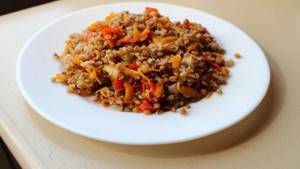
Buckwheat goes well with various vegetables, while remaining a low-calorie dietary product. A buckwheat diet with vegetables for weight loss is not only healthy, but also very tasty. When choosing vegetables, you should exclude potatoes and corn, as they contain a large amount of carbohydrates. Compositions of buckwheat and vegetables can be baked, cooked in a slow cooker, or the porridge can be eaten with a salad of raw vegetables.
Approximate diet for a week
In the morning you can prepare salad and buckwheat, and throughout the day distribute them into small portions. Most of the cereal should be eaten in the morning to provide the body with energy for the whole day. During the daytime, it is better to reduce the consumption of porridge, but increase the amount of vegetable salad.
Breakfast – porridge + one of: boiled green beans, stewed cauliflower, boiled or fresh carrots with herbs and olive oil, you can supplement your morning diet with tea without sugar.
Lunch – porridge + one of: cucumber salad, tomato, bell pepper, boiled broccoli, Peking salad with herbs, vegetable soup, pumpkin cream soup, stewed carrots; you can supplement your daily diet with vegetable juice.
Dinner – porridge + vegetable cabbage rolls, vegetable salad with herbs, vegetable cream soup, tomatoes with celery, boiled carrots and cauliflower.
In addition to vegetables, you can also eat various fruits. It is best to eat 1 glass of buckwheat and about a kilogram of vegetables and fruits.
Selection of buckwheat and its preparation
Do you think that all buckwheat is the same? This is wrong. Since the processing and storage conditions are different, the taste qualities may also differ. To find the best buckwheat for your diet, you need to know what to look for when choosing.
What to pay attention to:
- For packaging. She must be whole. No breaks. Otherwise, moisture will get inside, which will significantly reduce the quality of the product. As a rule, cellophane is now used for packaging. This material is quite strong and absolutely does not allow moisture to pass inside.
- Color spectrum. Brown grains have undergone special steam treatment. Suitable for those who like to eat crumbly porridge. A creamy tint, giving off a yellowish or green color, indicates that the product is natural and not steamed, which means that such cereals are more healthy. Dark brown buckwheat with a reddish tint will bring less benefit, since it was not steamed, but fried. Small industries use this method. High-quality buckwheat is considered to be kernels with smooth edges of the same shade. If you see that in one package there is a mixture of buckwheat of different colors, then it is better to set it aside. After all, the cooking time for each type is different and it will be quite difficult to maintain a balance during cooking.
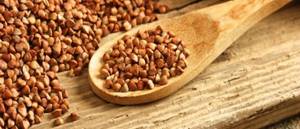
- Taste qualities. If you feel bitterness or sourness, you can safely return the product to the store. This means that the storage conditions were violated.
- Smell. Low-quality buckwheat can smell moldy, musty and other unpleasant odors. It is unacceptable.
- Best before date. Experts say that it is not calculated from the date of packaging, but from the harvest. But not every manufacturer can provide this information.
Cooking buckwheat is quite simple. Pour a glass of cereal into a saucepan, pour two glasses of boiling water and leave to steam overnight.
Excellent buckwheat is obtained if you cook it in a slow cooker or double boiler. But if you want to quickly, then pour the cereal into a frying pan and fill it with water. Cook while stirring until all the water has evaporated.
Buckwheat and fruit diet
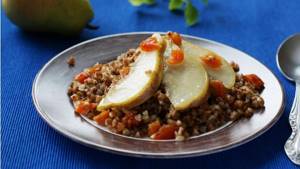
Combining buckwheat and fruit is not only a good way to lose weight, but also a very tasty and satisfying dish. Due to the richness of vitamins and fiber in the composition, you can forget about all the side effects. The extra pounds will go away a little slower, but with such deliciousness, you definitely won’t go astray. The course takes 10 days, the result is -5 kg. If you want to achieve a greater effect, it is better to start introducing fruits from the fourth day of the diet. Citrus fruits and apples are more suitable for the diet; other fruits are higher in calories.
Approximate diet plan:
- Breakfast – steamed porridge + baked apple or orange.
- Lunch – boiled porridge + banana or apples.
- Dinner – brewed porridge + grapefruit or any other citrus.
The choice of fruits for the diet depends on individual taste preferences. You are allowed to drink juice or tea without sugar, as well as snack on fruit. It is better not to overuse bananas, and eat one banana every few days.
Recommendations
1. Drink at least 2 liters of water per day. “Naked” (without nothing) tea is also allowed - green is better, try to give up coffee or at least drink no more than 2 cups a day.

Fotolia
2. Very important: chew buckwheat thoroughly before swallowing. Here it is appropriate to remember the yogi rule: solid food should be drunk, and liquid food should be eaten.
3. If you plan to go on a diet for more than three days, you can add a liter of low-fat kefir on the fourth day.
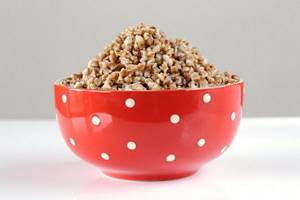
4. Also, instead of kefir, you can add berries and fruits (no more than a kilogram per day) 3 days after the “naked” buckwheat diet, but be sure to follow the principles of separate nutrition: eat berries at least half an hour before buckwheat and no earlier, than 2 hours after.

Fotolia
5. And the most important rule, judging by the numerous reviews of those who have lost weight on the buckwheat diet, is that you must have a mega-stimulus, mega-motivation to lose weight, since this certainly effective diet requires a lot of willpower.
But if you follow these simple rules, you are guaranteed to lose 3 to 10 kilograms!
Although the buckwheat diet is considered practically harmless, there are still contraindications to it:
- diabetes;
- stomach ulcer;
- various gastritis;
- any intestinal disorders;
- severe metabolic disorders;
- severe diseases of the cardiovascular system.
If you liked the article, share it with your friends!
Buckwheat and egg diet
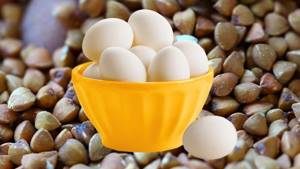
By adding eggs to your buckwheat diet, you can alleviate all the hardships of this method of losing weight. Thanks to egg whites, the body is charged with an optimal portion of energy.
The optimal daily diet is 2 liters of clean water, 5 soft-boiled eggs and any amount of buckwheat porridge without spices. All this is distributed throughout the day, depending on your own preferences. It is best to saturate your body in the morning and eat most of the porridge without eggs. Snacks with fruits and vegetables, tea without sugar, and freshly squeezed juices are acceptable, but in small quantities. In two weeks of such a diet, approximately 10 kg are lost.
How many kilograms can you lose on buckwheat?
This diet is quite effective and on average allows you to get rid of 1 kg every day . But the duration of a strict diet should not exceed 14 days, since in some cases, after this period, the body becomes accustomed to the regime, and the weight loss process stops.
What happens if you eat only buckwheat for a month?
If you want to extend the diet for a month or more, keep in mind that the body will respond with disruptions . The most common reaction is constipation. Possible indigestibility of cereals due to a failure in the production of enzymes necessary for its digestion (depletion of function).
There may be disturbances in the functioning of the urinary system and kidneys, even hormonal imbalance is possible.
Buckwheat diet with meat

Porridge can only be supplemented with dietary meat. For example, chicken, turkey or rabbit, lean fish. It is better to eat meat boiled once a day, or cook broth in it. Not everyone can eat meat without spices and even salt, so they rarely go on such a diet. You can lose 6 kg in two weeks using it. Freshly squeezed juice from fruits or vegetables, tea without sugar, raw vegetables and fruits can also dilute the diet. But you should consume them in small portions throughout the day.
Buckwheat recipes
And at the end of this article there is a nice bonus - several recipes for buckwheat dishes. They do not relate directly to the diet itself, but can be useful to any housewife.
Ingredients: 200 g buckwheat, small onion, butter, a couple of chicken eggs.
The cereal should be poured into boiling water and covered with a lid. In this state, it should cook for about 15 minutes, and then let it brew for the same amount of time with the heat off. Fry finely chopped onion and hard-boil eggs, and then add them to the porridge. The final touch will be a piece of butter.
Buckwheat casserole
Ingredients: buckwheat 200 g, chicken egg, small onion, hard cheese 50 g.
Finely chop the onion and fry until crispy. Beat a raw egg in a bowl, grate the cheese on a fine grater. Mix all this thoroughly with boiled buckwheat, put it on a baking dish and put it in the oven. The dish will take about 15 minutes to prepare at a temperature of 200 degrees.
Buckwheat and water diet
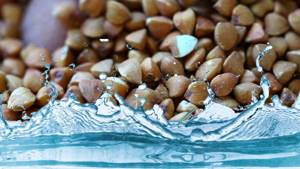
Buckwheat on water without additional products is a strict regime, which is designed for a maximum of three days (if the body reacts normally to such a diet, you can extend it for a couple of days). During this period, excess liquid and an additional 3-4 kg will be lost. The diet should be divided into 5-6 meals. In between meals, drink purified water and unsweetened tea. If you feel unwell in the form of dizziness and weakness, it is better to replenish your glucose level with one spoon of honey. If you perform a lot of physical or mental activity during the buckwheat drinking diet, you can dilute the diet with one apple per day.
Detailed menu for the week
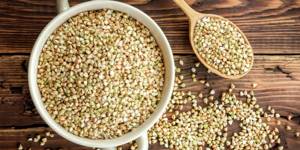
There are several diet options:
- Fasting day. The most gentle option. You just need to “sit” on buckwheat for 24 hours.
- Three days. A relatively safe and effective diet. You are allowed to eat one buckwheat and drink water.
- Five-day. Then it is better to supplement the diet with fruits so as not to lose strength at all.
- Seven days. The result is impressive, however, it is difficult to follow the diet for a whole week.
There are also options for 10 and 14 days. They are especially popular before the start of summer and upcoming holidays at sea, but are suitable only for people with considerable willpower.
Since the list of allowed products is small, there is no point in writing out the menu for every day.
The classic power supply looks like this:
- 2 glasses of water in the morning;
- half an hour later, a portion of buckwheat;
- a glass of water after 45 minutes;
- another portion of porridge in an hour.
You can eat up to 6 servings of buckwheat per day. Water can be replaced a couple of times with green or mint tea without sugar.
The list of dishes on the seven-day diet looks like this:
- buckwheat on water;
- kefir;
- unsweetened fruits;
- some dried fruits;
- small portions of vegetables;
- smoothies or fresh juices;
- a little boiled chicken.
You need to eat three times a day without snacking. Buckwheat is a staple food product. As an additional dish, you can eat one of those suggested on the list.
A diet with added protein is more gentle. The kilograms on it go away more slowly, but more reliably, since they don’t come back later.
An approximate daily diet should look like this:
- breakfast – buckwheat without salt (you can add honey or dried fruits if desired);
- lunch - baked vegetables (not potatoes) and a piece of steamed fish or lean meat;
- dinner – buckwheat and kefir.
There is another variation of this diet.
During the day you can eat buckwheat as much as your heart desires, but for dinner you need one of the proposed dishes:
- cottage cheese;
- boiled chicken fillet or beef;
- soft cheese;
- omelette;
- kefir.
A more varied menu allows you to eat less strictly and get used to constantly eating buckwheat.
Lightweight options are often used for a kind of training. The first time they try one of the light varieties of diets, then they switch to normal nutrition, and the second time they “sit down” on a strict, classic mono-diet.
Which diet is better: buckwheat or drinking?
It is impossible to say for sure which diet is most effective - buckwheat or drinking. It all depends on the characteristics of the body and willpower. If you start a strict diet and then fail, there will be no effect. The best option would be to go through a three-day drinking diet, and then smoothly supplement it with one of the above methods of losing weight, and continue it for up to two weeks. Then it will be easier for the body and higher efficiency.
If the buckwheat diet is the first way to lose weight in life, you should definitely go through it only comprehensively and under no circumstances torture yourself with strict fasting. You can ruin your health at any time - but in this case it’s unlikely that you’ll be able to lose weight.
Lack of essential amino acids
Buckwheat is a complex carbohydrate of plant origin. But the body needs essential amino acids, which are found only in products of animal origin (meat, eggs, dairy products).
ON THE TOPIC Kim Protasov's diet: pros, cons and unexpected opinion of a nutritionist
For example, meat and cottage cheese retain water in the body. And when we stop consuming them (because we eat only buckwheat), the liquid is not retained in the body. And because of this you lose weight. As a result, you lose water, muscle mass and then fat. And the right diet for losing weight is when you lose fat first, and then some water. And you don’t lose any muscle mass at all.
Buckwheat diet results

Within two weeks after finishing the diet, you should eat buckwheat porridge at least once a day. It is best to eat it in the morning. It is allowed to add vegetables, meat or fruits, as well as spices. Alcohol should be avoided and try not to eat fatty foods. This way out of the diet is the most optimal. You shouldn’t eat at night either, and don’t increase the portions sharply.
Physical activity and fitness will strengthen the effectiveness of the buckwheat diet.
A strict regimen or mixed diet on buckwheat gives excellent results. During the first two days, the body “dries out” and excess fluid (about 3 kg) leaves. A two-week course burns up to 15 kg. Due to the monotony of the strict diet, many do not survive even three days. This is not a problem, quite the contrary, but the efficiency may be slightly reduced. Nutritionists and girls who have already tried this method are very fond of the buckwheat diet. If you are overweight, it is recommended to repeat the course every couple of months. But this is only if the general condition of the body allows you to make a new breakthrough.
How much weight can you lose on a buckwheat diet is the main question of interest to all girls. It is worth understanding that the result depends on the initial weight, or more precisely on the height/weight ratio. If you are 165 cm tall and weigh about 100 kg, then you can lose more than 15 kg. But if your height is 170 and your weight is 58, then the result will be small.
There are no bad consequences of a buckwheat diet with the right approach. During the diet itself, some side effects may occur: apathy, weakness, dizziness, pain in the epigastric region. The most important thing is health, and not the speed of burning extra pounds, so if it’s too hard, it’s better to finish it and avoid serious problems.
How much weight can you lose in 5 days?
By eating buckwheat porridge alone for the specified time, you can lose up to 5 kg. This result can be achieved not by eating porridge alone, but by combining this process with moderate physical activity and long walks. It is worth paying attention that the weight will not go away immediately. In the first 1-2 days, no changes are usually observed. The result is noticeable on the third or fourth day.
Did you know? Buckwheat was brought to the territory of European countries by the Mongol-Tatars during the invasion. Because of this, she is often called Tatar in Europe.
Buckwheat diet cons
Yes, buckwheat is a very healthy product and the diet gives excellent results. But there is another side to the coin:
- Due to a strict mono-diet, the body does not receive the required amount of nutrients and elements necessary for the normal functioning of the body. As a result, the glands that produce enzymes for breaking down buckwheat are depleted and subsequently there is a risk that the body will no longer adequately perceive this grain.
- There is a risk of developing addiction to buckwheat. Therefore, you should not use it for more than two weeks. Otherwise, when returning to a normal diet, you will experience a pronounced “withdrawal syndrome.” That is, the body will refuse to accept other food for a certain period. This time there will be a pronounced intoxication syndrome (intestinal disorders, vomiting, subfibrile temperature, general malaise).
- The amount of vitamins in cereals is not sufficient, so hypovitaminosis of some groups may develop. To prevent this, you should include a multivitamin complex in your diet.
- Due to an unusual diet for the body, the following are possible: weakness, headache, dyspeptic disorders, drop in blood pressure, tachycardia, increased fatigue, exacerbation of chronic diseases. Therefore, in order to avoid possible harmful consequences of the buckwheat diet, you should consult your doctor and approach the start of the diet consciously.
In addition to a small list of disadvantages, the buckwheat diet has a number of contraindications. It is forbidden to start a mono diet if you have:
- stomach and/or duodenal ulcer (not only in acute form, but also chronic, even if you have a history of these pathologies, it’s not worth the risk);
- gastritis and frequent non-ulcerative colitis;
- diabetes;
- severe menstrual cycle or menopause;
- mental disorders;
- surgical operations on the abdominal organs during the last two years:
- pregnancy, postpartum period, lactation.
You should also not start a strict diet for children under 17 years of age. In childhood, the enzymatic system is underdeveloped + rapid growth, in adolescence - puberty + active growth. All this puts a lot of stress on the body, and overload will not do anyone any good.
If you follow all the rules and approach the “diet issue” seriously, the result will not be long in coming. A flow of motivation and fortitude, all the difficulties of a strict mono-diet will be overcome, and expectations will be justified. The main thing is not to be too happy with the result and not to start eating everything. The right way out of the diet is rational nutrition.
Rules and principles of nutrition
As a rule, during the buckwheat diet it is recommended to drink kefir. This fermented milk product is an excellent source of protein and vitamins A and B. In addition, it maintains normal intestinal microflora and helps gently cleanse the gastrointestinal tract. Therefore, the combination of buckwheat and kefir is considered very successful.
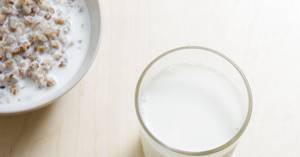
However, you need to remember that kefir must be made at least 24 and no more than 72 hours ago. Otherwise, in the first case it can cause indigestion and flatulence, in the second case it can cause constipation. The fermented milk product must be low-fat or a maximum of 1% fat.
Basic Rules:
- all spices and sauces are prohibited;
- You are allowed to drink up to 5 glasses of kefir per day;
- You should drink at least 1.5 liters of liquid per day;
- It’s better not to eat before going to bed, just drink a little kefir;
- at the slightest deterioration in health, it is better to stop the diet.
You don’t need to set a goal to lose weight in a week and immediately lose ten kilograms. Drastic weight loss can lead to stretch marks, and the achieved result is very difficult to maintain.
And in order to prevent a lack of vitamins and minerals, it is necessary to take dietary supplements.
Buckwheat diet - lose 20 kg in a month
We eat buckwheat and lose weight up to 20 kg per month.
Please note that it is very difficult to withstand such abuse of your body. The buckwheat diet is not for the faint of heart and is an extreme diet that can not only reduce your weight, but also ruin your digestive system.
For example, I survived one day, and then for a long time I spat at the sight of any cereal.
But the buckwheat diet certainly has an effect.
A friend followed the diet for 10 days. The nerves, of course, were naughty. But 12 kg remains the same.
By the way, she says that the buckwheat diet, or rather, this mockery of herself, disciplined her so much that for a year she does not eat after six and goes to fitness once a week. That is, the kilograms lost after the buckwheat diet did not return.
For fun, you can also read one story about losing weight on a buckwheat diet.
As an option, there is a buckwheat diet with dried fruits.
Then the headaches caused by the complete absence of sugar will disappear.
But, as you understand, it will take longer to lose weight.





